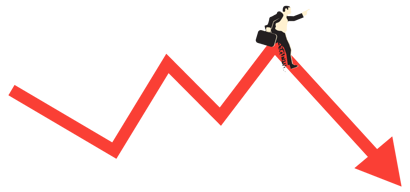Manufacturing predictions for 2023 paints a picture of an industry facing a range of challenges and opportunities. In this report, we explore seven trends—from workforce shortage to supply chain resiliency that will reshape the manufacturing industry in Europe and the UK. Along with insights into how you can leverage digital technologies and adopt strategies that drive resiliency in your business.
For a quick overview, you can download our infographic here.

BIGGEST CHALLENGE
The energy crisis poses a threat to Europe's industrial sector
The biggest challenge manufacturers are facing for 2023 is how to cope with disruption to the energy supply. Energy prices in key industrial regions are sky-high as countries struggle to secure dependable sources.
Wholesale electricity and gas prices have surged 15-fold since early 2021(1).
- The International Monetary Fund
The European Commission has released its action plan for the energy sector with "Digitization" as its key enabler to improve efficiency and renewable integrations. Similarly, the way that manufacturers will manage energy consumption will become more reliant on IoT (internet of things) devices.
IoT technology brings various connectivity and inter-networking benefits that can monitor and address your daily operational energy use. This technology can be linked closely with productivity, and on-floor activities, to measure process effectiveness while identifying ways of reducing energy consumption. Forrester predicts that 30% of manufacturers will pivot IoT investments to reduce their energy bills(2).

STRATEGY
Building resilient supply chains
Ongoing supply chain disruptions, volatility in commodities markets, lockdowns abroad, and rising operating costs continue to pressure the manufacturing sector. Fortune reports that more than 94% of Fortune 1000 companies have suffered significant supply chain disruption, which is being felt both by businesses and consumers.
60% of European and US companies plan to re-shore some activities in the next three years.
- BCI Global
Is it time to rethink suppliers?
Suppose disruptions have resulted in noticeable delays in your production. In that case, it's time to examine your sourcing capabilities. Having faced one problem after another, supply chain managers are shifting their focus from "just in time" to "just in case" eventualities. Research from BCI Global shows that over 60% of European and US companies plan to re-shore activities in the next three years and prefer less risky but costlier markets such as the Czech Republic, Poland, and Hungary(3).
Digitize supply chain planning
As companies address supply chain issues, they must consider how their operational processes can support visibility, demand planning, supply planning, and inventory optimization. To achieve operational resilience, you must consider what part your technology plays.
Read more: How technology provides stability during unstable times

THREAT WATCHLIST
Cyber-attacks on the rise
As cyber-attacks are becoming more frequent and sophisticated, manufacturers find themselves in an increasingly vulnerable position to these threats. In 2022, manufacturing was reported to be the most targeted industry for the second year, making up 20% of double extortion ransomware attacks(4). It's a lucrative business, Reuters reports that ransomware attacks have increased threefold since 2020, with ransoms rising from $416 million for all of 2020 to $590 million for the first six months of 2022(5). This has resulted in fraudsters increasingly targeting more prominent industries due to the likelihood of being paid.
Some attacks may have a spillover effect far beyond their original targets as the malware spreads. Manufacturers need to invest in cybersecurity measures to protect themselves from these threats. Forrester recommends increasing or defending your digital investments to include: API security, cloud workload security, multifactor authentication, security analytics, Zero Trust network access, and crisis simulation exercises(6).
Click here to learn how an IT security vendor uses Norwegian mountains to protect global data

STRATEGY
Investing in an economic downturn
The global economy is facing a number of challenges, including rising debt levels, political uncertainty, and trade tensions. According to Forrester’s 2022 data, the majority of online adults in the US (64%), UK (59%), and France (55%) are anxious about the possibility of a recession(7). The pandemic, growing economic uncertainty, geopolitical conflict and escalating costs have added to the current economic slowdown(8), which is likely to impact manufacturers. As a result, businesses are reexamining their expenditure costs. This focus on essentialism will tap the breaks on transformation and force businesses to focus on core business drivers: resilience and efficiency(9).
How can businesses strengthen their resilience?
- Digital technology
- Implement fast and flexible processes
- Address short-term issues as well as long-term challenges
10% of automation budgets will shift from transformation to resilience
According to Forrester, uncertainty with the economy will push executives to a cost-saving mindset regarding automation investments and instead focus on known business issues and risks(10). Manufacturers that are able to adapt to the changing economic conditions and invest in new technologies and processes will be well-positioned to succeed in the future. For example, a UK electronics manufacturer needed to be able to respond to customer needs and product development quickly. This led to a decision to focus on lifting its internal processes and quality measures by implementing new technology. The move allowed the company to gain a sustainable growth solution for managing spending priorities, operational flexibility, and risk mitigation.
Read more: How a global electronics manufacturer is future-proofing operations
TRENDS
The enterprise Metaverse
The enterprise metaverse is an emerging technology that enables virtual and augmented reality to be used in the workplace. This technology has the potential to revolutionize the way manufacturers work by enabling them to visualize and interact with complex information in new ways. A report by Grand View Research found that the global enterprise metaverse market is expected to reach USD678.8 billion by 2030, growing at a CAGR of 39.4% during the forecast period(11). So far, manufacturing is leading the way in moving the metaverse precursors toward more integrated environments(12).
It all depends on business maturity
The Metaverse enterprise may take some time to materialize fully, and often it's industry leaders with big budgets who jump on new technology first. However, companies within the SMB market should take advantage of their end-to-end management systems. Your technology should allow you to reinvent your processes with APIs and train your team within a digital test system to achieve better outcomes rather than replicating existing experiences and dated techniques.
Read more: Future-proofing your business

NEW OPPORTUNITIES
The green market revolution
The world is facing an environmental crisis, and manufacturing finds itself at the forefront as the industry alone is responsible for 34% of greenhouse emissions in the European Union as of Q2 2021(13). Consumers increasingly consider their carbon footprint and strongly prefer buying environmentally products (14). A 2023 report by Euromonitor found that recession-era spending habits are likely to lead to more consumers being frugal about purchases. As a result, the number of Zero Wasters is expected to grow, with value for money, durability, and quality becoming more significant factors in shaping consumer purchasing decisions(15).
As the growing demand for sustainability and greener industry practices grows in relevance, we will likely see manufacturers increasingly adopt sustainable practices and produce eco-friendly products.
European environmentally conscious consumer groups will increase by 50%(16)
- Forrester
The green market will change how we design products
Discrete manufacturers are well positioned to understand and manage their environmental impact, thanks to progress in digitizing their operations. At a strategic priority level, Forrester highlights that 64% of the 200 global manufacturing firms identified greenhouse gas emissions reduction targets as part of their strategic sustainability initiative(17). Much of a product's carbon footprint in production and usage is determined during its design phase. The green market revolution allows businesses to optimize their products' cost, quality, and performance with longer lifecycles, which can withstand irreversible climate change effects and address new use cases.
Read more: Marine fuel cell company strikes green gold

STRATEGY
The future of work
After nearly three years of pandemic-induced disruption, manufacturers face new challenges regarding attracting new talent to the industry. The future of work is likely to be shaped by a range of factors, including automation, artificial intelligence, and post-pandemic workplace flexibility. Your frontline team members are the primary creators of value. Acting now to reconfigure your workplace value proposition can help bring in new talent for the largest segment of your workforce.
Finding and keeping your talent
With many businesses unable to recruit externally for critical roles, Forrester predicts that talent mobility will increase up to 25%(16). Internal talent marketplaces will open a broader conversation about workforce agility, reskilling, and giving employees more ownership of their careers. When attracting new talents to the industry, businesses should evaluate their employment value proposition to manage expectations, work-life balance, and flexibility.
Investment into automation will slow down in 2023
Automation, by now, is familiar news for the manufacturing industry. Robots do not take breaks; they can do repetitive mundane tasks faster and with precision and enrich your frontline workers with new skill sets. However, most automation tasks go through the cycle of completing static processes. As a result, organizations are shifting focus and are looking for value in data-driven methods to improve their automation investments. This year, Forrester predicts that 35% of enterprises that depend on human physical ability will integrate physical robots with mainstream tech(17). This includes events triggered by IoT devices or state changes in Machine Learning applications which will transform end-to-end business processes.
Read more: Employing technology to work smarter, not harder
Thanks for reading! We look forward to bringing you more industry insights this year. If you have any questions regarding future-proofing your operations, we'd love to hear from you.
Overall, these predictions signals change in the business environment correlates with anticipated changes in the supply network. Moreover, manufacturers gain a strong competitive advantage by implementing sustainable initiatives through investments in their digital transformations. Therefore, keeping ahead of these trends is extremely important for businesses to manage supply risks, adjust sourcing and pricing strategies, and identify and seize new market opportunities
Did you like what you read? Click here to download the Manufacturing Predictions 2023 PDF. Or download the infographic.


